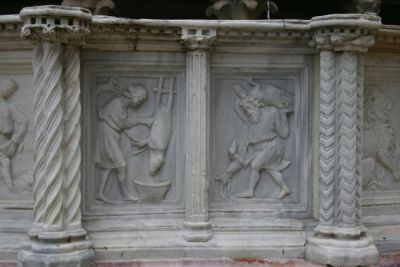Prosciutto, pancetta, salami, salsicce, coppa, barbozza. The names unite in an enticing rhythm, so appealing to your ear. Even if you are a vegetarian.
Recently, I dropped in at the house of my Umbrian rural neighbors Peppe and Gentile. I found their daughter Paola and her husband Leandro, a norcino (pork butcher), putting finishing touches on many of these items. “Gifts” from the two pigs 88-year-old Peppe had raised and Leandro had butchered two days prior.
Traditionally in Umbria, the butchering of the pig takes place after the feast day of Sant’Andrea (November 30) and before the feast of the patron saint of animals, St. Anthony Abbot (January 17).
On the late 13th century fountain in Perugia’s main square, the month of December is represented in two sculpted panels depicting the pig slaughter and the butchering by the norcino. Capricorn is represented in the upper left-hand corner of the first panel. Leandro had butchered the pigs on the last day of the period of Capricorn.
For the ancient Romans, il norcino was the expert in the butchering and castration of pigs as well as the transformation of the meat into various cuts for aging cooking. Due to his notable manual skills, il norcino also came to the aid of those with tooth problems such as abscesses and simple bone fractures. In the Middle Ages, the butchers in the small mountain towns around Norcia, in southern Umbria, were so adept at the butchering of pigs and creation of pork products that they worked all over central Italy during wintertime.
Leandro is a retired stonemason now and becomes a norcino only in the winters, turning the pork meat into prosciutti and insaccati just for family. He and Paola were busy at work making salsicce (sausages) in the cantina area when I arrived. Ten fat salami were ready to hang for seasoning, until Easter when traditionally the insaccati are first tasted. Leandro had rinsed out the pig intestines with red wine for use as casings for the sausages (others had been used for the salami). Outside the door, the pig’s skull, ears, snout, bones, cartilage, and la cotica (pig skin) – in rural culture, every part of the animal is used, no waste! – for coppa boiled in a blackened huge copper cauldron. The coppa is not cured and is consumed fresh with added spices and orange peels.
Peppe had gathered acorns for months for the two pigs slaughtered this year. The prosciutti (salt-cured hams) of the other pig he had raised were already salted and spread out below slabs of pancetta (bacon) just off Paola and Leandro’s work area.
With 10 salami made, they were working on the sausages, Leandro holding the casings (the intestines he had cleaned with Peppe’s red wine) for the pork meat a smiling Paola was grinding. Leandro then poked through the casings to assure that the pork meat would “breathe,” thus avoiding rancidity. Both quickly and deftly worked at tying the encased meat, creating sausages. I saw such artistry in those pink spirals. Paola pointed to the remaining ground meat, telling me it would be used for polenta.
Before I left, I asked Paola her feelings about the work she and Leandro had shared that day. She replied with a wide smile, “The transformation of the pig into prosciutto, salami and all this other goodness is one of my earliest memories. Since I was about eight years old, I have been helping out every year on the norcino tasks. There can’t be January without the pig slaughter.” They both waved with wide smiles as I headed out. As I looked back at la casa di Peppe e Gentile, I knew I had just shared an episode of rural life and a winter tradition that would soon be extinct. What a privilege.
https://www.lagazzettaitaliana.com/travel/10124-an-umbria-january#sigProId6465556277




